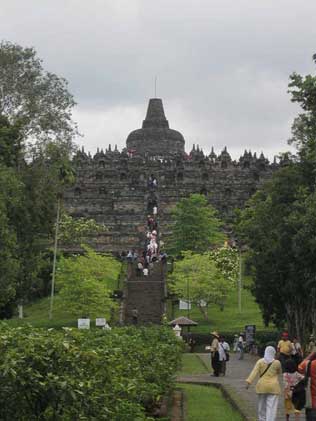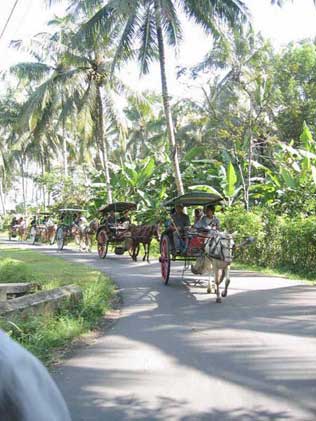Borobudur Fun Heritage Trail: Yogyakarta, Central Java
 There is no doubt that the beauty, glory, and magnificence of the world heritage site, Borobudur temple, is well known not just across Indonesia but also around the globe. Yet, little may be known about the surrounding areas that are no less interesting destinations and can be enjoyed while visiting Borobudur — the largest Buddhist temple in the world built around the 7th and 8th centuries, located some 60 kilometers north of Yogyakarta.
There is no doubt that the beauty, glory, and magnificence of the world heritage site, Borobudur temple, is well known not just across Indonesia but also around the globe. Yet, little may be known about the surrounding areas that are no less interesting destinations and can be enjoyed while visiting Borobudur — the largest Buddhist temple in the world built around the 7th and 8th centuries, located some 60 kilometers north of Yogyakarta.
Among the human achievements are beautiful natural landscapes, the exoticness of traditional Javanese communities tending to their daily activities, and the uniqueness of traditional cuisines and rituals.
“Riding a horse-drawn cart through the traditional villages indeed offers a different experience of enjoying a visit to the temple, making it even more meaningful to visitors,” heritage activist Laretna T. Adishakti said recently.

Laretna, also called Sita, is a lecturer and researcher at Gadjah Mada University’s Center for Heritage Conservation.
Sita was in Borobudur to guide a group of visitors on the “Borobudur Fun Heritage Trail“, a special tour that incorporates cultural landscape surrounding the ancient temple.
Some 70 participants had joined the tour, which was jointly organized by the Culture and Tourism Ministry, the United Nations Education, Scientific and Cultural Organization (UNESCO)-Jakarta, and Jogja Gallery.
The tour group comprised of journalists as well as senior and junior high school students, while the same tour was held previously for a group of senior high school teachers.
“Borobudur has been overburdened with thousands of people visiting it every year,” said Sita, underlining the importance of introducing the cultural attractions around Borobudur to the greater public.
This way, according to Sita, the surrounding communities would benefit financially from tourists visiting the heritage site, and Borobudur could be preserved at the same time.
At least five sites, including the temple, were on the tour’s agenda that day, which was conducted mostly via andong — horse-drawn carts — with three to four participants to a cart.
The other sites were the villages of Tuksongo, Tanjungsari, Karanganyar and Candirejo.
Tuksongo was on the tour program for its traditional production center of pati onggok — sago palm flour — and glass noodles.
Tanjungsari is known for its tofu production while Karanganyar is a center of traditional earthenware.
Participants gathered at the Borobudur Tourism Information Center, a kilometer to the east of the temple, where they were divided into two smaller groups so the andong caravan would not stretch out too long en route to the scheduled sites. The two groups were assigned separate trails, and the tour was off.
The first group took a route through Tuksongo, Tanjungsari, Karanganyar, and Candirejo; the other started at Karanganyar then continued through Tanjungsari and Tuksongo, to regroup at Candirejo.
A feeling of exotic nostalgia arose once tour members boarded their andong and rolled to the clopping rhythm of the horses.
The leisurely tour revealed views of traditional kampongs with shady trees — mostly fruit trees — lining the village roads, with grinning children and villagers waving or nodding their heads in greeting, and traditional houses with spacious yards.
“Hellooo!” several children cried as they ran alongside the carts as the tour passed them.
“The residents here are used to having tourists visiting their villages like this,” Yusuf, an andong driver, commented spontaneously.
Yusuf, 60, said he had frequently taken tourists to areas around Borobudur, adding that tourists were welcome to join the villagers in harvesting rice and vegetable crops, as well as pick fruits grown in private gardens.
“But you have to tell them prior to the visit so that they can arrange that for you,” he advised.
Enjoying a panoramic view of the temple atop its hill, creating a backdrop to a green expanse of rice fields as farmers tended to the harvest, adds another level of excitement for visitors on the heritage tour.
“This is truly something that we could never enjoy at the temple,” said Ratna, a journalist on the tour. “From here, the temple looks much more glorious and magnificent to me.”
At strategic points where photographic opportunities were evident, participants were indeed welcome to alight from the andong to take pictures or simply to enjoy the beautiful scenery.
“I will surely come back here later and bring my family to enjoy all of this. I might even spend a night or two here,” Ratna added.
Visitors can stay in the area at local accommodations for a night or more to further explore the surrounding area. Candirejo village, only some 3 kilometers to the south of Borobudur, has 50 or so home stays open to visitors.
Over the past four years, the village has been developed steadily into a tourist destination, and offers several different tour packages, including a cooking class on traditional cuisines and snacks.
Candirejo was also where that day’s Borobudur Fun Heritage Trail participants stopped by for a rest and lunch.
From there, the andong journey continued to Borobudur. Upon ascending the temple’s steps, tour participants were able to recognize the places they had just visited. And from the temple’s many relief panels, they were able to learn about daily life in the past, which made the visit much more meaningful.
On the return trip to Yogyakarta, this time on buses, participants were taken for a short visit to a nearby river to trace the remains of a prehistoric lake believe to have once surrounded Borobudur temple.
Geologist Helmy Murwanto of the Yogyakarta-based UPN Veteran’s University accompanied this part of the tour, explaining his recent scientific findings on the existence of the lake.
The findings and ongoing research on the lake has inspired heritage activists to design possible trails for special-interest groups, keeping in mind the benefits to local communities and heritage conservation.
“Heritage conservation is not romanticism of the past. In fact, it is for developing the future by sustaining the potentials of the past toward select development today,” Sita said.
As regards Borobudur in terms of heritage conservation, she continued, it was not just about the monument’s physical structure but also its intangible aspects, including culture, potentials and the daily life of surrounding communities.
In line with this thinking, the Borobudur Fun Heritage Trail is available to everyone who wishes to enjoy the cultural landscape of Borobudur Temple.
The five villages visited above are just a few of the tour’s attraction.
Cultural landscape heritage, or pusaka saujana as it has been popularized by local heritage activists, is defined as a mix of natural and cultural heritage within a unity of place and time.
“Unfortunately, the preservation of the cultural landscape here is not yet fully understood, regardless that Indonesia possesses one of the world’s largest mosaics of cultural landscapes,” said Sita, and that it was time for the government to start adopting the concept as part of its development policy.
Sri Wahyuni
Label: javanese culture

0 Komentar:
Posting Komentar
Berlangganan Posting Komentar [Atom]
<< Beranda